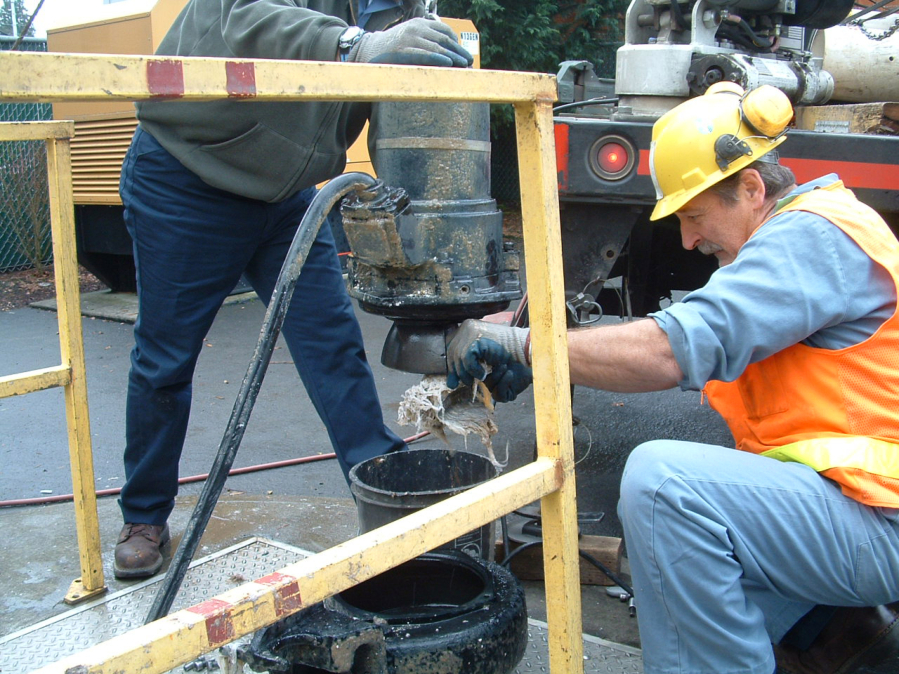With the diligence and attention of a team of midwives, Clark Regional Wastewater District employees helped a sewage pump birth a 100-pound wad of adult flushable wipes, which the district named Reggie.
Reggie was brought to a landfill almost as soon as it was pulled to the surface in May 2014, but its spirit lives on as cartoon character named Reggie the Rag Ball that teaches schoolchildren not to flush wet wipes and other junk down the toilet.
The wet wipes that constituted Reggie, and so many other blockages like it, have been a popular alternative to toilet paper for Clark County residents in recent years. While they may leave their users feeling fresh and clean after every flush, they’re an expensive and time-consuming problem for the people who manage the sewers.
“If you talk to the line maintenance guys and operators, they’ll tell you they just despise them,” said Frank Dick, wastewater engineering supervisor for the city Vancouver.
Dick and Shawn Moore, the assistant manager of the wastewater district, say the wipes don’t break down in between the time they’re flushed in a home or business to when they reach the sewer’s pumping stations.
“Then the pump tries to suck the wastewater in but the wipes circulate and tie themselves in a knot,” which plugs the pump, Moore said. At that point, crews have to go out and pull the pump out of the pumping station and “de-rag” it to get the wastewater flowing again.
The wipes are marketed as flushable, but Dick said what that means to the manufacturers versus what that means to municipalities doesn’t match. Dick said there are seven industry “flushability” tests materials go through that re-create a journey through the sewer system. One is the disintegration test, which sloshes a wipe around until it dissolves in three hours.
But Dick and many other municipal sewer leaders say wipes need to dissolve in around 30 minutes to prevent them from clogging wastewater pumps. He’s been working on a national level to get the industry to be more realistic about what it means for something to be flushable.
“That’s been an uphill battle,” he said. “I think the word flushability is so valuable to that industry — it’s big money.”
Despite the wipes’ continued popularity, the situation isn’t as bad as it was a few years ago, but it’s still a problem.
Between 2008 and 2013, the city spent $900,000 on new pumps — some of which were only about halfway through their life cycles — and equipment that was better equipped to handle wipes.
But before that, city workers were sometimes unclogging the same pump three times a week, Dick said. And the city was spending $78,000 a year to unclog pumps plus another $30,000 per year in additional electricity costs to run the clogged ones.
The district used to have to “de-rag” a pump just about every day until they started upgrading their infrastructure. Over the past five years the district has upgraded about 60 percent of its sewer pumps with more on the way, but clogging is still an issue.
“We send crews out there every couple days … then we have an on-call crew out on nights and weekends that a couple nights a week go out to lift a pump and clear it,” said Tom Burns, the district’s operations manager.
Now most of the wipes make their way through to the wastewater treatment plants, where they’re collected on debris screens, rinsed and shipped to the landfill. Including wipes and other debris, nearly 200 tons of material a year comes from the Salmon Creek plant alone.
Through a variety of outreach methods, utility officials are trying to encourage people to stop flushing their wipes, even if the packaging says they’re flushable. Doing so will save the sewer workers a lot of trouble, and potentially keep costs down.
“A homeowner can change their behavior and have a positive direct impact on the cost of maintaining and operating the collection system,” Moore said. “It’s a ratepayer-funded utility, and the cost to operate and maintain the utility is passed on to the consumer.”




